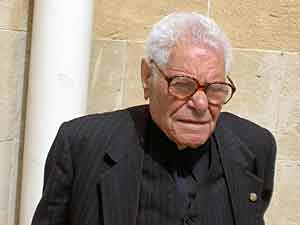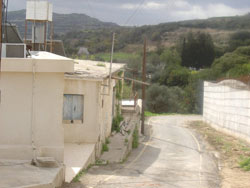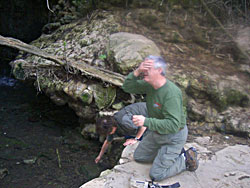By Max Hartshorne
GoNOMAD Editor
The island of Cyprus has attracted travelers for more than 10,000 years. Lying in the Mediterranean close to the border of Syria, Lebanon, and Israel, it is geographically, almost in the Middle East, but distinctively European.


In the summer of 1974, the Greek military junta then in power backed a coup on the island and declared it a part of Greece.
Turkey responded with 45,000 troops and occupied the northern part of the island. The Greek junta subsequently collapsed and the island was divided into the Republic of Cyprus and the Turkish Republic of Northern Cyprus.
Talk of the Island
This invasion and separation of the island is a subject that is still debated and regularly discussed in the newspapers more than 30 years after the fact.
Christina, our Greek-speaking guide, told us that when she was asked to guide a group into the Turkish area in the north, “I didn’t want to walk around the place and show [the tourists] the houses, restaurants, and shops that had been stolen from us.”
If you ask the Turks, of course, the story is very different. They maintain that atrocities against Turkish enclaves required the partition in order to save Turkish lives. The two sides almost reached an agreement in a 2004 initiative brokered by the U.N., but although the plan was accepted by Turkish Cypriot voters, Greek Cypriot voters rejected it.
Cyprus Today
Cyprus is a prosperous land where the average income is about $25,000 per year, the highest per capita wage in the region. Cyprus is in the midst of a major building boom.
Everywhere you look there are maisonettes, villas and condos being built or advertised for sale. From the look at the nation in 2006, they are poised for a huge growth in foreign investment and visitors.
Great Britain leads the way with over half of the 2 million visitors who come each year. But few Americans come to Cyprus, owing perhaps to the long flight over and because it is not as affordable as some other hot destinations such as Croatia and Slovenia.
But Cyprus is a unique destination and few other places offer so much scenery, history, and fine food in a compact land area.

Nicosia, the capital city, is also known as Lefkosia, its Greek name. During our visit to Nicosia, we went through the Laiki Yitonia (pedestrian quarter) where there is a platform overlooking the UN Green Line which separates the Turkish from the Greek part of the city.
“The last divided capital city” proclaims a sign at the gate where tourists can peer into the Turkish-controlled side of town. We took an elevator up eleven floors to the observation tower overlooking the north.
Cathedral Now a Mosque
Through binoculars, we saw a former cathedral that was converted into a mosque with twin minarets and Turkish flags flapping in the breeze and Turkish tourists gawking and waving at us from their own observation tower. We waved to the Turks who waved back. It seemed silly to be separated by this decades-old green line.
Emre Unel, a resident of Kyrenia, North Cyprus, told us that you can enter and stay in North Cyprus as long as you wish. Border formalities at currently three checkpoints are minimal. You may even cross with a Greek rent a car as long as it has insurance valid for the North. (Easily available at the border)
Many people who live in the North or wish to visit the Turkish part of Cyprus (including) use Larnaca airport. Any taxi will take you from there to any destination in the North without a hassle.
If you wish to enter North Cyprus directly the best way is to land at Ercan Airport (east of Nicosia). Ercan is served by the national carrier of North Cyprus, Cyprus Turkish Airlines, and other Turkish airline companies such as Turkish Airlines, Pegasus Airlines, Atlas Jet, Sun Express.
All international flights operate via Turkey. For instance, Cyprus Turkish Airlines operates daily to London (Stansted or Heathrow) via Turkey. Passengers stay on board, no plane change during a brief transit stop in Istanbul Izmir or Antalya. Cyprus Turkish also operates daily to all major Turkish Cities and weekly to Frankfurt, Germany.
Turkish Airlines provides worldwide connections via Istanbul including convenient daily connection flights to the USA. The airport can get quite busy with up to 40! daily departures.
Many Greek Cypriots fly out of Ercan for day shopping trips to Istanbul. (Up to 6 flights a day)
Most Visitors to Cyprus Come from Britain
This island has had many more troubles than a Turkish occupation. A series of conquerors from the Assyrians to the Greeks, then the Romans, Venetians, and Ottoman Turks all left their mark, and finally the British, who granted this nation of 750,000 their independence in 1960.

A windstorm had blown in over the night before we arrived, leaving dust on every vehicle and doorstep. The air was clouded, a taxi driver explained, with dust that blew over from the Sahara. In a day, the air was again clear.
My first impression of this 9,200 square-mile island were the sand dunes on the way from the airport. Rolling flat miles of undeveloped land lay on either side of the highway, as our driver flashed his high beams and honked anyone out of the passing lane where we whizzed along at about 90 mph.

In Greek Lefkosia, just about all the signs are in indecipherable Greek and in English. While all Greek Cypriots speak their native Greek, most also speak good English.
More than half the country’s visitors come from Great Britain, followed by Germany and Scandinavia. Few Americans come to Cyprus, but the numbers are increasing, thanks to cruise ships and an interest in discovering new destinations.
In Nicosia’s Cyprus Museum, we saw some of the treasures left behind by these conquerors. There are dozens of varieties of coins from all civilizations before the age of Christ and statues of emperors and of the goddess, Aphrodite, shorn of arms but still beautiful after all these centuries.
Each room of the exhibit is devoted to a different period so the visitors can get a sense of the many conquerors who put their stamp on this island nation over the centuries.
The Greek name for Cyprus lent itself to one of the earliest minerals used by man on earth—copper. The word means Cyprus. Early copper miners here drew the mineral from the earth in shallow mines; the museum depicts them in a diorama.
Many of the country’s oldest and finest mosaics were located in churches in the north. Sadly, during and after the 1974 invasion, most of them were removed from churches that were transformed into mosques.
Fortunately, the Nicosia museum has a great many beautiful mosaics which were recovered after being found in the U.S. and in Germany, and they are on view in plexiglass boxes here. It is incredible how much personality and emotion can be portrayed using the tiny tiles of the mosaics, such as the original of Leda and the Swan.
This would become even more apparent when we traveled to the south of the country to see the ruins at the Villa of Dionysis near Pafos harbor.
The Venetian’s Walls
Nicosia’s old city is surrounded by the old walls built by the Venetians to resist the invading Turks, who ruled here from the 13th to the 16th century. These huge, sandstone edifices, designed by the same military architect who built the walls of Iraklion on Crete, are where the famous Famagusta Gate, one of three entrances to the old city, is located. The modern city of the same name on the island’s eastern coast remains a modern day ghost town. Nobody has been there since 1974.
Famagusta’s old city remains inhabited, but the modern half is one of a few cities “being saved in case the Turks need to give something back,” our guide Christina told us. A photo essay in a magazine showed the city as an eerie ghost town, abandoned, with nothing changed since the abrupt departure of the Greeks 32 years ago. But enough about that.

The mild climate and fertile soils bring forth a bounty of fresh fruits, vegetables, and seafood. The meal of choice is meze—short for Mezedhes, or little delicacies.
It’s an endless parade of up to 30 small dishes, served one after another, family-style. It is a style of eating similar to tapas, but with bigger plates, it provides a wide selection of choices and new things keep arriving to enjoy.
Tavern at the Corner
We had meze at a roadside taverna outside of the city called Gonia tou Anastasi, or Tavern at the Corner. In a backroom, we began with Keo beer and tried zivania, the powerful local spirit similar to Italy’s grappa.
Each meal begins with tahini, skordalia, taramosalata and talattouri, the Cyprus dips of tahini and yogurt with fresh bread. Then, inexplicably, raw artichokes, (I never got the hang of how you can eat these tough fibrous vegetables raw, but here they do), and grilled halloumi cheese, which squeaks when you eat it.
Then grilled marinated pork seftalia – in chunks – and strips of chicken cooked with coriander, loukanika sausages and fried potatoes, and taro that looked just like beef. yogurt, followed by tiny grilled quail, a pause for some more Keo, then mushrooms and peppers, and later, more grilled pork.
A pause for water, then tiny round pastries filled with sweet cheese, and cinnamon-flavored pastries, then some Ouzo and more Keo and another shot of zivania. We didn’t finish until 10:30 p.m., when the city was just beginning to come to life.
South to Pafos

The most popular destination on Cyprus is Pafos, a town of about 150,000, on the Southern coast, where thousands of Brits enjoy the warm climate and all the comforts of home.
We stopped at a British-owned tavern called Mike’s Blue Velvet Pub, where we met Leslie, the forty-something bartender, who came here for a vacation and has been here ever since.
“There are so many nationalities, you hear so many different languages,” she said, “This town is magical, there’s something haunting about Pafos. I just love it.”
Pafos has a long stretch of road along the beach with lots of neon enticing travelers to “Try the Best Fish and Chips in Cyprus,” or rent a jeep. In February, when we were there, the street was lonely, but we were assured that in May and June the place is jumping like Fort Lauderdale.
Pafos has many levels of accommodation, from the deluxe Elysium Resort, right on the sea, with the amenities you’d expect from a five-star, to many more economical long-term rentals available with kitchenettes.
“We’re GOD,” said Leslie, “Growing Old Disgracefully.”
Everyone Speaks English
Everyone we met in Cyprus spoke both English and Greek, the latter in a Cypriot dialect. There is a happy-go-lucky feeling here and none of the anger that I’ve experienced in Greece with angry taxi drivers and people yelling at each other. Perhaps this has to do with the prosperity, absence of poverty and ghettos you find in most other nations. Cyprus boasts another bit of admirable self-sufficiency: nearly every house has a solar water heater on the roof.
Pafos
During the Roman occupation, Pafos was the capital of Cyprus, and as a result, many artifacts and ruins can be found here. As we drove along the sea, we saw the Troodos Mountains rising up to 2950 meters.
The area called Choirokoitia is a World Heritage site that provides a glimpse of life in 6000 BC. Here you can see a Neolithic village has been excavated and replicas of the small round huts once lived in by these people.
We visited a house in Kourion, outside of Pafos, where a display of mosaics shows life in ancient times in brilliant detail. The fourth century artwork depicting scenes from myths and fables is well-preserved. Here you can also see the Roman Theater, built in the 3rd century, with 3000 seats and near-perfect acoustics. Music and plays are still performed here. Kurion was destroyed by a tsunami and earthquake in the fourth century.
The Temple of Apollo
The first Temple of Apollo was built before 700 B.C. It was restored by the Roman emperor Augustus around 4 A.D. and by Trajan 100 years later. You can stroll the ancient walkway where animals were led to be sacrificed to this important god. Yellow lapsani flowers dot the windy ruins site and in the distance the Cyprus sea beckons in blue.
Further along the seaside highway, we found the fabled birthplace of Aphrodite, one large and then two successively smaller islands off the rocky coast. The legend is that this goddess of love was borne out of the foam of the sea.
Today, you can enjoy fish meze in the restaurant overlooking the sacred place. The fish meze, like the land version, doesn’t disappoint, and the menu is daunting. It starts with the same salad we found everywhere we went on the island. This was followed by plates of olives, yogurt and tahini, moving on to octopus, calamari, fried sardines and other fish, then grilled fish, potatoes, and more small plates until you can sample no more.
The Avakas Gorge by Jeep
Our trip included some opportunities to see nature up close. Above the beach at Pafos, we jumped into Land Rovers and drove up the steep rutted road into the 125 square kilometers of Avakas Gorge. Here a hiking trail led further and further up the gorge until it became too narrow for our Rover and we had to turn back.
Sea turtles come ashore at the beach in Pafos, and the entire area is a protected nature reserve. We drove along the shoreline looking out at the sparkling sea, as the road wound its way up and around the mountain, past olive, lemon and almond trees, and, of course, many vineyards. Pepper and carob trees also lined the roadside.
Spicy Cypriot Peppers
We tasted a few pods and felt the spice of the pepper. According to our guide, there are 150 plants that are unique to Cyprus. Our trip took us into villages that were once Turkish Cypriot settlements, in the days before 1974, both Greek and Turkish Cypriots coexisted peacefully. In the tiny speck of a village, there lived only one resident, an eighty-year-old farmer who still wears the traditional black pants and jacket of olden days. Tours like this one are about $65.
Limassol is the departure city for the many cruise lines that offer excursions to Israel, Lebanon, Syria and to Egypt, all less than a few hours cruising. Many large ships make stops in Cyprus from other middle East destinations.The island is famous for its 42 small vineyards that produce many unique wines, some with grape varieties that are unique to Cyprus.
The most famous of these is the Commanderia wine, a sweet variety that was once served to kings, and is produced near Limassol, the island’s second-largest city. It is the world’s oldest named wine, according to local lore.
Lunch in the Country
Lunch, at a country restaurant in the hills, called the Stone Tavern was the usual Cypriot assortment of fresh salads, small dishes like chard and eggs, black-eyed peas with onions, and course upon course of meats, chicken, and side dishes.
Sitting there enjoying this lunch, we thought about what our driver had said about the future of this beautiful island. He predicted that Turkey’s admission to the EU will force a compromise between Greeks and Turks. Like many Cypriots, he was quick to add that no one has a beef with the Turkish Cypriots, just with those from the mainland who invaded the country.
As we drank our Greek coffee, prepared over hot ashes with lots of sugar at the bottom, we remembered that little stone house we passed where a man and woman were sitting and thought that perhaps one day those Turkish Cypriots will be just as much at home here as their Greek Orthodox brothers. We hope for Cyprus that this dream comes true soon.
Eurail Passes: What to Know about Buying a Europe Train Pass
- Mongolia, the Land of Eternal Blue Sky - April 20, 2024
- These 9 U.S. National Parks Require Reservations in 2024 - April 17, 2024
- Take a Hike in Olympic National Park - April 17, 2024





